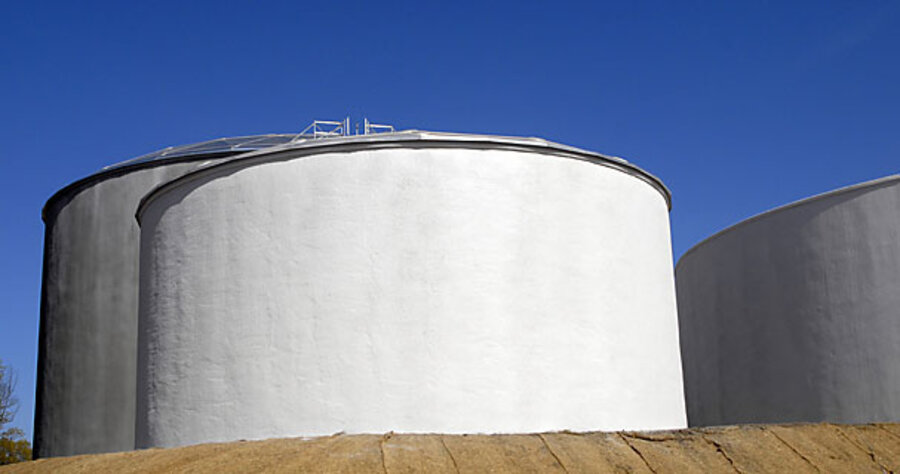Water-rich New England builds ... a desalination plant?
Loading...
| Dighton, Mass.
Far from the arid US Southwest and its longstanding water woes, or even the Southeast and its new water skirmishes – attitudes are shifting in lush New England.
That’s right. Despite abundant lakes and good rainfall, weak groundwater resources have crimped economic growth in some areas. As a result, the first big New England desalination plant turning brackish (salt water, fresh water mix) into fresh is expected to go online in Massachusetts this month.
That surprises some people, but not Robert Tannenwald, an economist and director of the New England Public Policy Center at the Federal Reserve Bank of Boston. Two years ago he did a study showing that New England – contrary to public perceptions – is not at all water-rich region, but one that needs to manage its water supplies more carefully and look for new sources.
“There’s still a general mind-set [in New England] that water as a resource is not in scarce supply – but it is,” Mr. Tannenwald says. “We waste a lot of water. There’s a lot of leaky pipes around here. So economics has to kick in and water has to be priced accordingly for the waste to stop.”
Initially, the Aquaria desalination plant, hard by the Taunton River a few miles from its mouth on Narragansett Bay, will supply 4 million gallons of fresh water each day to the city of Brockton 16 miles away. Using a reverse-osmosis process, it will filter salt and other impurities from brackish water flowing up the river from the ocean during high tide.
But not everyone is happy about what could become a regional trend. “The fact we are building desalination plants in New England is really a tragedy,” says Christopher Kilian, clean-water program director for the Boston-based Conservation Law Foundation. “This is a region that gets an immense amount of precipitation and where fresh water is being squandered. Before we start pouring costly desalinated water into the bucket, we should make the most of what we have and plug the leaks in the pipes.”
But Brockton has done that already, cutting water demand from around 11 million gallons per day to about 9 million. Now it needs the certainty that a steady supply of fresh water will bring to ensure economic growth, observers say.
Alfredo Andres is general manager of the new $60 million Aquaria desalination plant in Dighton, Mass., owned by Inima USA, the US subsidiary of Inima, itself a division of Madrid-based OHL.
“We’re glad to be here and think this plant will do a good service for towns in this area,” he says, looking out over the Taunton River beside the intake area and the net that keeps fish out.
Eventually, he says, a half dozen other communities could be served by the same pipeline if the plant one day expands its capacity.
“Obviously, the first thing a community must do is conserve its water and fix the leaks in its pipes,” Mr. Andres says. “But Brockton has done that and they still need water to grow. So do some of the other towns. We think this is the future.”
He may be right. With the decline in processing cost, desalination plants with a combined capacity of about 42 million cubic meters a day are operating worldwide today. They will surpass the 100 million cubic-meter mark by 2016, according to a 2007 report by the Zurich-based Sustainable Asset Management (SAM) group investment firm.
There are numerous desalination proposals being weighed for California and Florida, where Inima is also competing for work. Worldwide, the market for large-scale reverse-osmosis filtration systems is expected to grow nearly 50 percent over the next four years, according to the McIlvaine Company, a Northfield, Ill., market-research firm. Topping its sales list forecast is the US, followed by Japan, Saudi Arabia, China, and Spain.
“We expect to see the greatest growth in the area of desalination, especially in Asia and the Middle East,” Robert McIlvaine, the company president, said in a statement.
Desalination won’t do for Maude Barlow. The Canadian water warrior is worried that desalination puts control of clean water in the hands of corporations and undermines what should be strong efforts by government to stop waste and pollution of natural supplies.
In her view, the future could include desalination plants ringing the world’s oceans to produce costly water for the masses, while the rich will “drink only bottled water found in the few remaining uncontaminated parts of the world.”
But don’t tell that to Inima’s Mr. Andres.
“We think we’re doing something really good here,” he says. “People in this area need water – and we’re helping them.”





